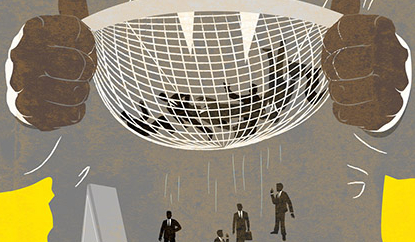中华人民共和国大气污染防治法(1)
|
(Adopted at the 22nd Meeting of the Standing Committee of the Sixth National People's Congress on September 5,1987 and amended according to the Decision on amending the Law of the People's Republic of China on the Prevention and Control of Atmospheric Pollution adopted at the 15th Meeting of the Standing Committee of the Eighth National People's Congress on August 29,1995 and revised at the 15th Meeting of the Standing Committee of the Ninth National People's Congress on April 29,2000) Order of the President of the People's Republic o China No.32 The Law of the People's republic of China on the Prevention and Control of Atmospheric Pollution, revised and adopted at the 15th Meeting of the Standing Committee of the Ninth National People's Congress of the People's Republic of China on April 29,2000, is hereby promulgated and shall go into effect as of September 1, 2000. Jiang Zemin President of the People's Republic of China April 29,2000 Contents Chapter I General Provisions Chapter II Supervision over the Prevention and Control of Atmospheric pollution Chapter III Prevention and Control of Atmospheric Pollution by the Burning of Coal Chapter IV Prevention and Control of Pollutants Discharged by Motor Vehicles and Vessels Chapter V Prevention and Control of Pollution by Waste Gas, Dust and Malodorous Gases Chapter VI Legal Responsibilities Chapter VII Supplementary Provisions Chapter I General Provisions Article 1 This Law is formulated for the purpose of preventing and controlling atmospheric pollution, protecting and improving people's environment and the ecological environment, safeguarding human health, and promoting the sustainable development of the economy and society. Article 2 The State Council and the local People's Governments at various levels shall incorporate the protection of the atmospheric environment into the national economic and social development plans, make rational plans for the geographical distribution of industry, improve scientific research in the prevention and control of atmospheric pollution and adopt measures to prevent and control atmospheric pollution, in order to protect and improve the atmospheric environment. Article 3 The State takes Measures to Control or gradually reduce, in a planned way, the total amount of the major atmospheric pollutants discharged in different areas. The local people's governments at various levels shall be responsible for the quality of the atmospheric environment within the areas under their jurisdiction, making plans and taking measures to ensure that the quality of the atmospheric environment within the said areas meet the standards. Article 4 The administrative departments for environmental protection under the people's governments at or above the county level shall exercise unified supervision over the prevention and control of atmospheric pollution. The administrative departments for public security, transportation, railways and fishery at various levels shall perform their respective functions in conducting supervision over atmospheric pollution caused by motor vehicles and vessels. Article 5 All units and individuals shall have the obligation to protect the atmospheric environment and shall have the right to inform or lodge charges against units or individuals that cause pollution to the atmospheric environment. Article 6 The administrative department for environmental protection under the State Council shall establish the national standards for atmospheric environment quality. The people's governments of provinces, autonomous regions and municipalities directly under the Central Government may establish their local standards for items not specified in the national standards for atmospheric environment quality and report the same to the administrative department for environmental protection under the State Council for the record. Article 7 The administrative department for environmental protection under the State Council shall, on the bases of the national standards for atmospheric environment quality and the country's economic and technological conditions, establish the national norm for the discharge of atmospheric pollutants. The people's governments of provinces, autonomous regions and municipalities directly under the Central Government may establish their local discharge norms for items not specified in the national norm for the discharge of atmospheric pollutants; with regard to items already specified in the national norms for the discharge of atmospheric pollutants, they may set local discharge norms which are more stringent than the national norm and report the same to the administrative department for environmental protection under the State Council for the record. Where the local norms for the discharge of atmospheric pollutants by motor vehicles and vessels established by the people's governments of provinces, autonomous regions and municipalities directly under the Central Government are more stringent than the national norm, they shall be subject to approval by the State Council. Units that discharge atmospheric pollutants in areas where local discharge norms have been established shall do so in conformity with such norms Article 8 The State adopts economic and technological policies and measures to facilitate the prevention and control of atmospheric pollution and the relevant multi-purpose utilization. Article 9 The States encourages and supports scientific and technological research into the prevention and control of atmospheric pollution, promotes the wide use of advanced and applicable technologies for such prevention and control; encourages and supports the development and utilization of clean energy like the solar energy, wind energy and water energy. The State encourages and supports the development of the environmental protection industries. Article 10 The people's governments at various levels shall redouble their efforts in afforestation, grass planting, urban and rural greening, and take effective measures that are suited to local conditions to prevent and control desertification so as so to improve the atmospheric environment. Chapter II Supervision over the Prevention and Control of Atmospheric Pollution Article 11 Projects which discharge atmospheric Pollutants shall be built, expanded or rebuilt in compliance with the State regulations requiring environmental protection in respect of such projects. In the statement regarding the environmental impact of a construction project, the atmospheric pollution the project is likely to product and its impact on the ecological environment shall be assessed and measures for its prevention and control be specified; and the statement shall, in accordance with the specified procedures, be submitted to the administrative department for environmental protection for examination and approval. Before a construction project is put into operation or to use, its facilities for the prevention and control of atmospheric pollution shall be subject to inspection and acceptance by the administrative department for environmental protection; no construction projects that fail to meet the requirements specified in the State regulations requiring environmental protection in respect of such projects shall be permitted to be put into operation or to use. Article 12 Units that discharge atmospheric pollutants shall, pursuant to the regulations laid down by the administrative department for environmental protection under the State Council, report to the local administrative department for environmental protection the facilities installed for discharging and treating pollutants and the categories, quantities and density of the pollutants discharged under regular operation conditions and submit to the same department the relevant technical data concerning the prevention and control of atmospheric pollution. The units that discharge pollutants, as mentioned in the preceding paragraph, shall without delay report on any substantial change in the categories, quantities or density of the atmospheric pollutants discharged.They shall deep their facilities for treating atmospheric pollutants in regular operation; where the said facilities are to be dismantled or left idle, the matter shall be reported to the local administrative department for environmental protection under the people's government at or above the county level for approval in advance. Article 13 No units may discharge atmospheric pollutants in excess of the density specified by the State of by local authorities. Article 14 The State institutes a system under which fees are charged discharge of atmospheric pollutants on the basis of the categories and quantities of the pollutants discharged and establishes reasonable rates for such fees according to the need for improved prevention and control of atmospheric pollution and the country's economic and technological conditions. The rates fixed by the State shall be applied in collecting the fees for discharge of pollutants, specific measures and the procedures for their implementation shall be prescribed by the State Council. All the fees collected for discharge of pollutants shall be turned over to the Treasury and shall be used for the prevention and control of atmospheric pollution as prescribed by the State Council and may not be used for other purposes. And the auditing authority shall, in accordance with law, exercise supervision over their use through auditing. Article 15 With regard to the areas, where the specified standards for the quality of the atmospheric environment are not met, and the acid rain control areas and the sulfur dioxide pollution control areas designated as such with the approval of the State Council, the State Council and the people's governments of provinces, autonomous regions and municipalities directly under the Central Government may delimit them as the areas where the total amount of the main atmospheric pollutants discharged is kept under control. The specific measures for such control shall be prescribed by the State Council. The relevant local people's governments in the areas where the total amount of the atmospheric pollutants discharged is kept under control shall, in compliance with the requirements and procedures prescribed by the State Council and in line with the principles of openness, fairness and impartiality, check and fix the total amounts of the main atmospheric pollutants discharged by enterprises and institutions and issue them permits for discharge for such pollutants. The enterprises and institutions that undertake to control their total amounts of atmospheric pollutants discharged shall discharge pollutants in conformity with the checked and fixed total amounts of the main atmospheric pollutants to be discharged and the requirements in respect of their discharge prescribed by the permits. Article 16 Within the scenic or historic sites, nature reserves, the areas adjacent to historical or cultural sites under protection and other zones that need special protection, delimited as such by the State Council or the people's governments of provinces, autonomous regions and municipalities directly under the Central Government, no industrial production installations that cause environmental pollution shall be built; the pollutants discharged by other installations to be built in these areas may not exceed the norms prescribed. Enterprises and institutions that discharge pollutants in enforcement of this Law, have built installations that discharge pollutants in excess of the specified norms shall, in accordance with the provisions of Article 48 of this Law, put such pollution under control within a time limit. Article 17 The State Council shall designate key cities for prevention and control of atmospheric pollution in accordance with the overall plan for urban development, the planned target for environmental protection and the quality of the atmospheric environment of cities. Municipalities directly under the Central Government, provincial capitals, open coastal cities and key tourist cities shall be included in the list of key cities for prevention and control of atmospheric pollution. Key cities for prevention and control of atmospheric pollution that fail to meet the standards for the quality of the atmospheric environment shall be required to do so within the time limit specified by the State Council or the administrative department for environmental under the State Council.The people's governments of such cities shall make plans to meet the standards within the time limit and may, under the authorization of the State Council or on the basis of its regulations, adopt more stringent measures to fulfil such plans on such plans on schedule. Article 18 The administrative department for environmental protection under the State Council together with the relevant departments under the State Council may, in light of the meteorological, topographical, soil and other natural conditions, delimit the areas where acid rain has occurred or will probably occur and areas that are seriously polluted by sulfur dioxide as acid rain control areas or sulfur dioxide pollution control areas, subject to approval by the State Council. Article 19 Enterprises shall give priority to the adoption of clean production techniques that are instrumental to high-efficient use of energy and reduced discharge of pollutants so as to decrease the generation of atmospheric pollutants. The State practises an elimination system for the outdated production Techniques and equipment which cause serious pollution to the atmospheric Environment. The competent department for comprehensive economic and trade affairs under the State Council shall, in conjunction with the relevant departments under the State Council, publish a catalog of the techniques which cause serious pollution to the atmospheric environment and the which shall be prohibited within a time limit, and a catalog of the equipment which causes serious pollution to the atmospheric environment and the production, sale, importation and use of which shall be prohibited within a time limit. Producers, sellers, importers or users shall, within the time limit specified by the competent department for comprehensive economic and trade affairs under the State Council in conjunction with relevant departments under the State Council, discontinue the production, sale, importation or use of the equipment listed in the catalog as mentioned in the preceding paragraph. Users of the production techniques listed in the catalog mentioned in the preceding paragraph shall, within the time limit specified by the competent department for comprehensive economic and trade affairs under the State Council in conjunction with the relevant departments under the State Council, stop using such techniques. No equipment eliminated in accordance with the provisions of the preceding two paragraphs may be transferred to another for use. Article 20 Any unit that, as a result of an accident or any other exigency, discharges or leaks toxic or harmful gas or radioactive substances, thereby causing or threatening to cause an accident of atmospheric pollution and jeopardize human health, shall promptly take emergency measures to prevent and control the atmospheric pollution hazards, make the situation known to such units and inhabitants as are likely to be endangered by the atmospheric pollution hazards, report the case to the local administrative department for environmental protection and accept its investigation and disposal. Under the urgent circumstances of a severe atmospheric pollution that jeopardizes human health and safety, the local people's government shall make the matter known to the local inhabitants without delay and take compulsory emergency measures, including ordering the pollutant discharging unit concerned to stop discharging pollutant. Article 21 The administrative departments for environmental protections and other supervisory departments shall have the power to make on-site inspections of the units under their jurisdiction that discharge pollutants. The units under inspection shall truthfully report the situation to them and provide them with the necessary data. The inspecting departments shall have the obligation to keep confidential the technological know-how and business secrets of the units inspected. Article 22 The administrative department for environmental protection under the State Council shall set up a monitoring system for atmospheric pollution, organize a monitoring network and work out unified monitoring measures. Article 23 The administrative departments for environmental protection under the people's governments of large and medium-sized cities shall regularly publish bulletins on the quality of the atmospheric environment and gradually introduce the practice of forecasting the quality of the atmospheric environment. A bulletin on the quality of the atmospheric environment shall include such contents as the characteristics of the urban atmospheric pollution, the types of the main pollutants and the degree of the harm caused by the pollution. Chapter III Prevention and Control of Atmospheric Pollution by the Burning of Coal Article 24 The State promotes the dressing of coal by washing to reduce the sulfur and ash in coal, and restricts the mining of high-sulfur of high-ash coal. If the coal mined from a newly-built coal mine is of high-sulfur or high-ash, supporting facilities for the dressing of coal by washing shall be installed to keep the sulfur and ash in coal within the limits prescribed. If the coal mined from an established coal mine is of high-sulfur or high-ash, supporting facilities for the dressing of coal by washing shall, in accordance with the plan approved by the State Council, be installed within a time limit. It is prohibited to mine the coal containing toxic or harmful substances, such as radioactive and arsenic substances, that exceed the limits prescribed. |








